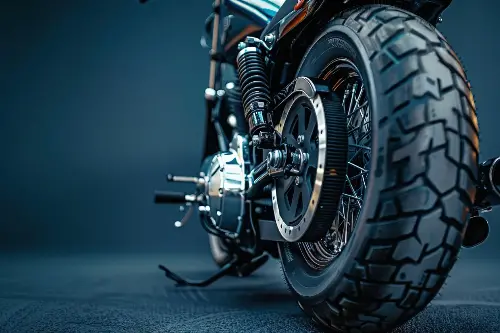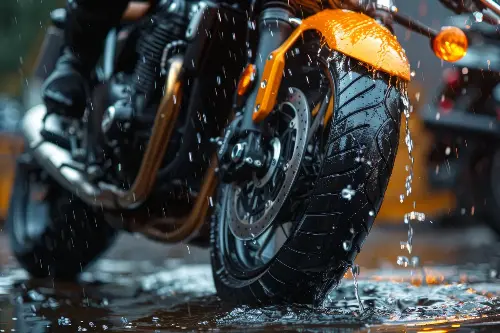Selecting the optimal motorcycle tyres for your machine is not just a necessary maintenance task; it is vital for ensuring a safe and enjoyable riding experience. The choices available can be overwhelming, but understanding the type of tyre that matches your riding style and the conditions you typically face is imperative. Here we dive into the intricacies of motorcycle tyres to help you make an informed decision.

Understanding Tyre Types
Motorcycle tyres come in various shapes and sizes, each designed for specific conditions and riding experiences. 'Touring' tyres are designed for long distances and provide comfort and durability, while 'sport' tyres are tailored for maximum grip and performance at high speeds. 'Off-road' tyres offer enhanced traction in unpaved conditions, and 'dual-sport' tyres strike a balance between on-road efficiency and off-road capability.
Identifying the Right Tyre Size and Specifications
The size and specification of your motorcycle tyres are critical to performance and safety. The alphanumeric code printed on the sidewall of the tyre informs you about its width, aspect ratio, construction type, and diameter. It’s essential to consult your motorcycle's owner manual or the tyre placard for the manufacturer-recommended tyre size and specifications to maintain the correct handling characteristics and speedometer accuracy.
Tread Pattern Insights
The tread pattern on motorcycle tyres isn't just for aesthetics; it’s engineered to expel water and maintain traction in wet conditions. Sport tyres often have fewer grooves for greater road contact, but this means they are not ideal in the wet. Touring tyres have more intricate tread patterns for better water displacement. For off-road use, tyres have knobs and deep grooves for maximum grip on dirt and gravel.
Consider Compound and Construction
The compound of a tyre refers to the rubber mixture used in its construction. Softer compounds provide a sticky feel for a better grip but tend to wear down quickly. Harder compounds last longer but offer less grip. A balance is struck with medium compounds, suitable for everyday riders.
Radial and bias-ply are the two main construction types. Radial tyres have layers running at a 90-degree angle to the direction of travel, which makes them flexible and better for sporty riding. Bias-ply tyres have layers that run diagonally, giving them a stiffer sidewall, appropriate for heavier bikes or touring motorcycles where load-carrying is essential.
Seasonal Considerations and Weather Adaptability
In areas with distinct seasons, considering the weather conditions in which you'll be riding is non-negotiable. Winter tyres for motorcycles have unique tread patterns and rubber compounds designed to cope with colder temperatures and slick surfaces. Conversely, summer tyres are made to withstand hot asphalt and deliver optimal performance in dry conditions.

Mileage and Longevity Expectations
If you spend a significant amount of time on the road, longevity is a critical factor. Touring tyres are engineered for higher mileage, with compounds that resist wear and tear from long-distance cruising. However, they may not offer the same level of performance in terms of agility and speed responsiveness as specialised sport tyres.
Balancing Performance with Safety
While the temptation to go for high-performance tyres is always present, it's crucial to not overlook safety. Each tyre has a speed rating and a load index that should not be exceeded for your motorcycle's make and model. The speed rating indicates the maximum speed at which the tyre can carry the load specified by the load index for an extended period, a vital consideration for riding safety.
Reading Reviews and Seeking Expert Opinions
Exploring reviews and reaching out to professionals can ease the decision-making process. Motorcycle enthusiasts and experts can share insights from their experiences, giving you perspective on how different tyres handle in real-life conditions. Don’t hesitate to ask for recommendations at your local motorcycle shop or on online forums dedicated to biking enthusiasts.
When to Replace Your Tyres
It’s not just about choosing the right tyre but also knowing when to replace it. Look out for signs of wear such as bald spots, bulges, or excessive tread wear. Most tyres have wear indicators in the grooves that signal when the tread has reached its safe limit. Also, be mindful of the tyre's age; rubber deteriorates over time, so even if the tread looks adequate, an old tyre may still need to be replaced.
Making the Final Choice
Ultimately, the best motorcycle tyre for your needs balances performance, safety, and longevity appropriate for your typical riding environment. Always consider what you primarily use your bike for - be it cruising on highways, navigating city streets, or adventuring off-road. Your decision should marry your practical requirements with your personal preferences for a ride that is both thrilling and secure.
By equipping yourself with the right tyres, you are not only enhancing your motorcycle's performance but also ensuring a safer journey, no matter where your travels take you. With the proper knowledge and understanding laid out in this article, you are now better prepared to tackle the decision of selecting the perfect set of tyres for your beloved bike. Happy and safe riding!
